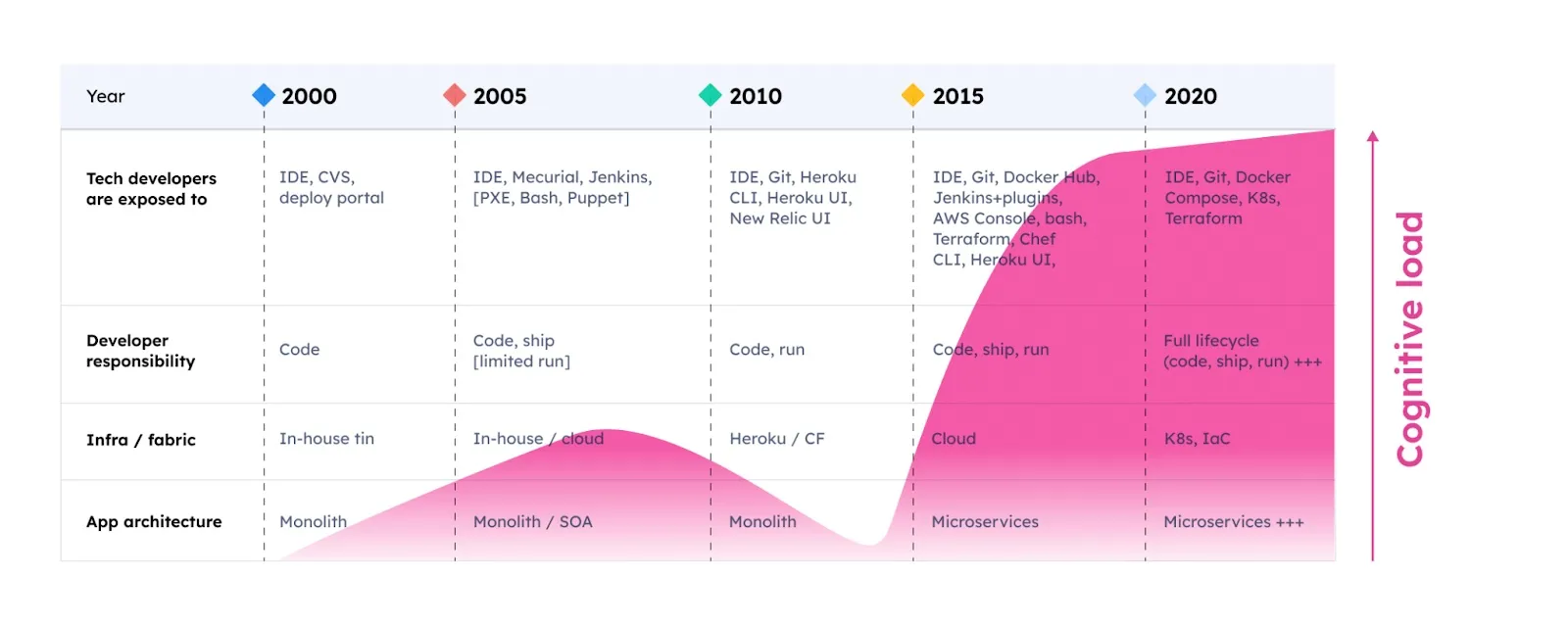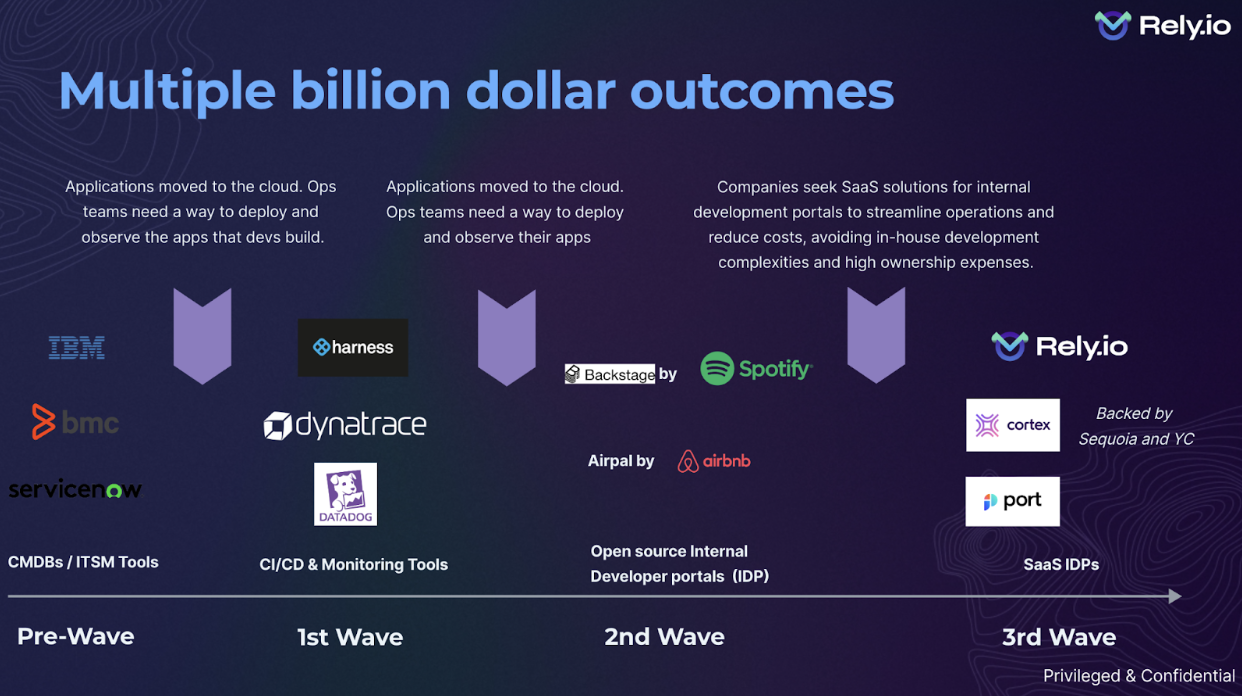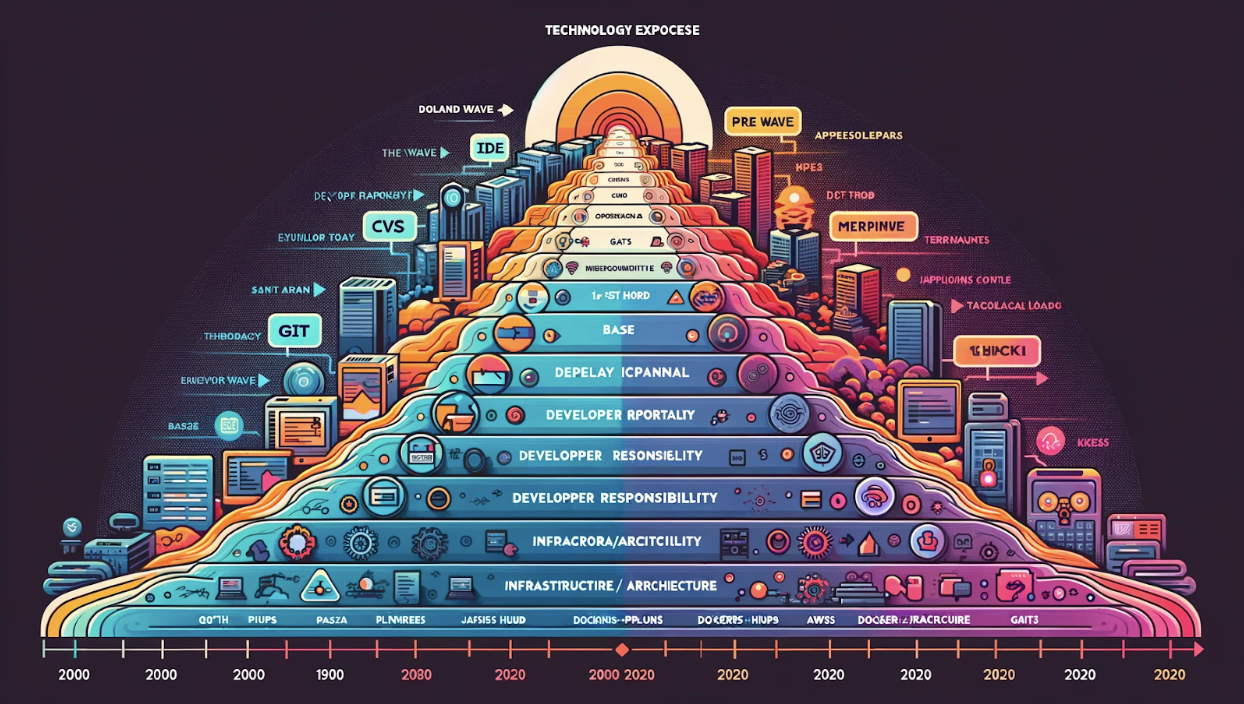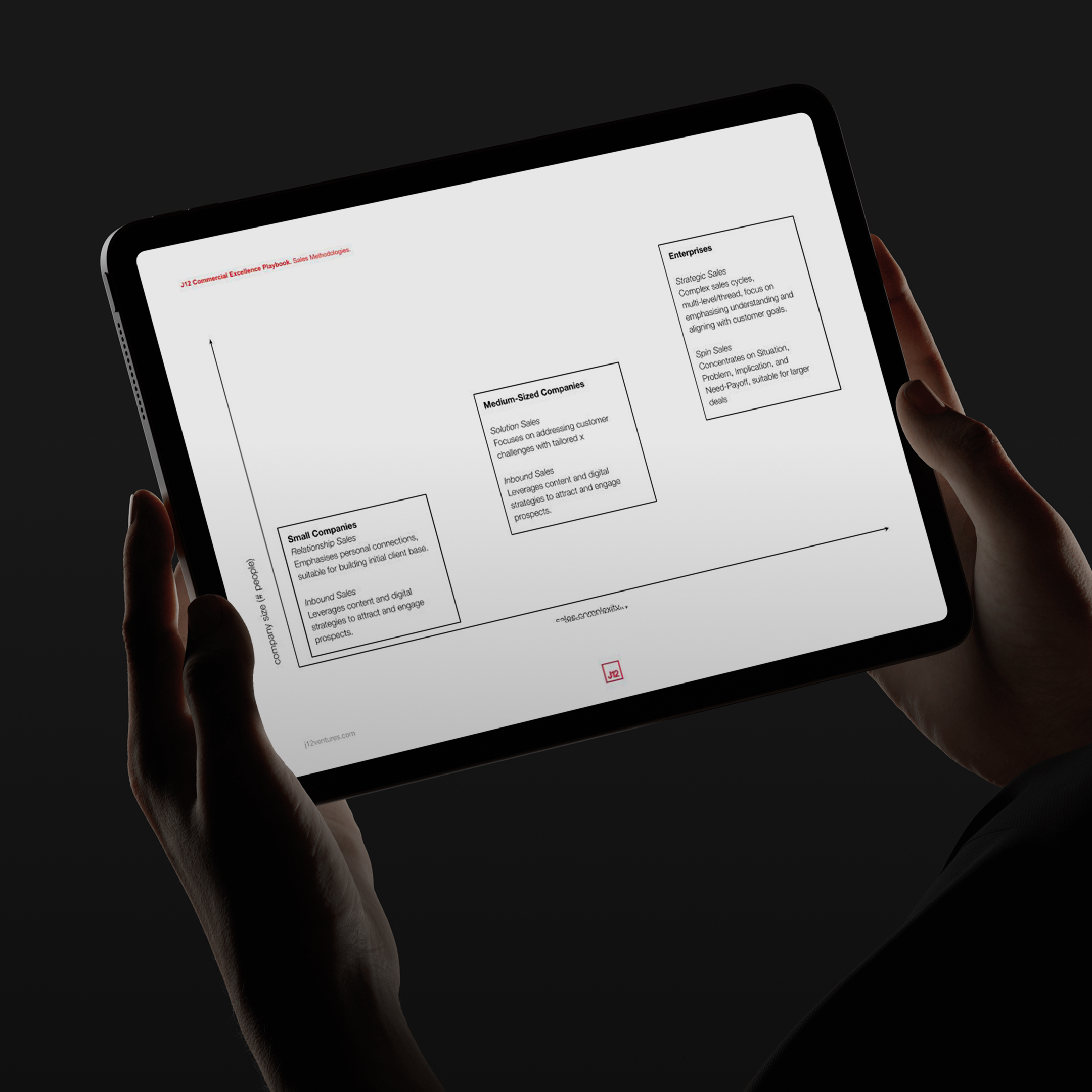How to Build a Commercial Toolbox
A thesis on how platform engineering has become an evermore complex task, increasingly demanding solutions to manage all processes and tools. Empowered by LLM capabilities, Internal Developer Portals have an important role in the upcoming decade and will become an indispensable tool for any engineering team, creating a new multi-billion, or even trillion dollar industry.
Why now? From Code to Complexity

The infographic snapshots a two-decade sprint in the tech development realm, where the starting line in 2000 was a simpler time with IDEs, CVS, and deploy portals. Developers' minds were laser-focused—write the code and pass it on.
Fast forward to 2005, the landscape's complexity crept up with Jenkins and Bash. The cloud was a mere wisp on the horizon, and developers dipped their toes into the operations pool, but monoliths still ruled the architecture block.
The 2010 mark brought Git and Heroku into the mix, putting more on the developer's plate—code it, ship it, run it. The cloud grew from a puff to a presence, but the monolith stood its ground, unchallenged.
By 2015, Docker and AWS threw their hats in the ring. Tools proliferated like rabbits, and microservices began to edge out the monolithic monuments of yore. Now, developers weren't just coding—they were shipping, running, and on-call 24/7.
By 2020? The toolkit exploded—Serverless, Docker Compose, K8s, Terraform—and the full lifecycle of an app was now in the developers' hands. 'Cognitive load' wasn't just a buzzword; it was the bane of the dev life. Infrastructure turned to K8s, and apps were now a complex web of microservices.
Today, engineering teams suffer from lack of discoverability, inconsistent UI, repetitive Toil.
1) Discoverability
The vast sea of critical data is often dispersed across a myriad of locations, tools, and hyperlinks, presenting a time-consuming challenge in locating what is needed. So even if one remembers the services (which is often a problem too) - knowing how and where to access them remains a challenge to be solved.
2) Inconsistent UI
The patchwork of internal tools, each with its unique interface and quirks, demands developers become jack-of-all-trades, mastering countless systems. A uniform UI is essential to eliminate the steep learning curve associated with juggling these disparate environments.
3) Demotivating work
The large number of infrastructure tools create a tide of monotonous tasks—setup, configuration, maintenance—siphoning precious time and stifling creativity. This routine toil, resistant to automation, bogs down development and is costly not only in terms of developer hours, but maybe worse, in terms of motivation and ability to focus on what creates business value.
Enough is enough: Enter the Internal Developer Portal (IDP) — the Digital Command Center for Engineering Teams
As tools and tasks multiplied, the developer's brain-space became prime real estate. Enter internal developer portals, the tech world's answer to simplifying the chaos. They consolidate the sprawl into a one-stop digital command center with a single unified experience - solving 1) Discoverability, 2) Inconsistent UI and 3) Demotivating Work —tools, docs, support, you name it—trimming the cognitive clutter and letting devs get back to what they do best: building the future, one line of code at a time.
The Trillion Dollar Industry: Orchestrating Platform Services and Developer Portals
Over the last two decades giants like ServiceNow (founded 2004, today ~$160b market cap) have been addressing the service management of how to run an IT environment - started during an era of static Virtual Machines and Data Centers, before the dominance of cloud computing, naturally the challenges are different and make the giant a clear legacy provider.

Historically the market of IT orchestration, platform services, and now developer portals has evolved in three waves according to Rely.io’s founder José Velez:
Pre-Wave: Designing Foundations for Cloud Transition
In the initial sketches, giants like IBM, BMC, and ServiceNow laid the groundwork. Their tools for Configuration Management Databases (CMDBs) and IT Service Management (ITSM) provided the scaffolding for applications shifting to the cloud, enabling ops teams to deploy and monitor the digital structures developers crafted with precision.
1st Wave: Erecting Robust CI/CD and Monitoring Frameworks
Harness and Dynatrace, reinforced by Datadog, started to construct robust frameworks for Continuous Integration/Continuous Deployment (CI/CD) and monitoring. This phase marked an era where developers could erect and supervise their applications in the cloud with improved efficiency and oversight, ensuring seamless deployment cycles.
2nd Wave: Drafting Open Source Developer Portals
Then, open source innovators like Spotify with Backstage and Airbnb with Airpal, shared their blueprints for internal developer portals. These platforms have been like open source templates that any enterprise could customize for their own development landscape, aiming to cut costs, bypass the complexity of in-house development, and reduce the fiscal footprint of proprietary systems.
3rd Wave: Streamlining with SaaS IDPs
In the more recent wave, companies like Cortex, Port, and Rely have started to streamline the build process with SaaS Internal Developer Portals (IDPs), offering a ready-to-use solution for development teams. These portals simplify the management maze, providing a unified experience where developers can efficiently craft and control their applications, allowing them to concentrate on innovating and coding without getting lost in the information and tool proliferation nightmare.
*If you want to learn more about IDPs I suggest reading this article by Rely.io
IDPs for the AI era — A powerful LLM Enabled Development Ally.
First, I asked ChatGPT to visually draw me the future. It’s crystal clear; you gotta love the predictive nature of LLMs.

More seriously. In the future developer portals will act as the go-to interface between developers (and perhaps even non technical people) and their software ecosystems. Allowing people to simply write or speak what they want to to achieve.
Since the developer portal typically integrates with all the interfaces of the engineering tools, when empowered with AI, people will be able to ask any question or ask it to do any action and it will convert the request into the appropriate answer or action.
Most interestingly, it would be fair to assume that no other product would be able to do so, nor AI on its own due to the unstructured nature of all this data across services and data sources.
Hence, over time the key function of IDPs will be to structure all widely spread information into a single data model, becoming a powerful development ally to every developer focused on building the future, one line of code at a time.
Part 9/10
Once you have created a sales playbook, there are hundreds of existing resources you can leverage to create a library of practical tools and templates for aiding your GTM. I have selected five to get you started, which based on my experience are good building blocks for sales effectiveness and complementary to a playbook.
1. Growth Hacking
Growth hacking is a strategic approach that focuses on finding the most effective methods to expand a business through experimentation (think classic A/B testing specifically applied to growth and sales initiatives). This innovative tactic has proven to significantly accelerate growth, enable faster monetization, and foster a mindset centred on expansion. The process begins with a scientific approach, formulating a hypothesis centred on potential growth avenues. This hypothesis then serves as the foundation for a series of experiments, the results of which are analysed to draw meaningful conclusions. Examples of potential growth strategies to experiment with include, building an email list, partnering with other brands, or cultivating a community, among others.
Further reading on distinct Growth Hacking strategies for Acquisition, Activation, Retention, Revenue and Referrals: 2O Ultimate Growth Hacking Strategies for Startups
…
2. Account Planning & Collaboration
For successful planning, fostering a collaborative environment is paramount. Utilising digital platforms that offer valuable templates and tools can significantly enhance team collaboration and instil structured workflows. These platforms facilitate effective communication, idea sharing, and joint decision-making, all of which are crucial for planning and execution. You can also access a lot of effective templates to help with account management and revenue expansion initiatives to apply and deploy with customer accounts once they are acquired.
Example of such a digital platform: Miro Templates Library
…
3. Sales Profile/Personality Assessments
Sales Profile/Personality Assessments, such as the DiSC assessment, are tools designed to evaluate an individual’s personality traits and behaviours and are often applied in a sales context. They provide tools to help guide sales performance management and coaching and enablement plans for managers and reps alike. Best used in collaboration with other evaluation tools and generally requires a degree of personalisation and individual interpretation to be applied and adopted effectively. As always, the key is to not only apply these tools at a moment in time, but to ensure they become part of an on-going programme of continuous assessment and evaluation of performance. This is how you engrain objective scoring into your sales culture and drive high-performance over-time.
…
4. Social Selling
Social selling is a modern sales approach that leverages social networks to locate and engage with prospects. LinkedIn is the most common social networking platform used for B2B sales propositions and its ‘Sales Navigator’ solution is basically LinkedIn on steroids. Built for sales reps and teams to prospect for new leads more effectively, Sales Navigator increases your pipeline and can aid closing more deals. Sales Navigator offers a 30-day free trial period and unlocks many additional features and functionality (e.g. more powerful search capability, more tailored recommendations, more customised feed, better list building, etc). Something to consider even in the start-up phase. Definitely something to harness as you start to scale and the sales team grows to 10+.
Further reading: LinkedIn Sales Navigator
…
5. Sales Planning
Wasting time in inefficient and poorly run meetings is a huge drain on sales effectiveness and leads to admin creep and impacts output and performance. A well-crafted simple 1-page meeting plan not only fosters efficiency but also ensures that your sales meeting objectives are met in a systematic and engaging fashion. Sales should be selling, not stuck in a cycle of internal meetings that aren’t driving results. Numerous template examples are readily available, providing a wealth of resources to draw from. Renowned SaaS companies, including Salesforce, have set benchmarks by publishing their effective meeting agenda templates. These can serve as valuable references when designing an agenda that suits your specific needs.
Further reading: 10 Secrets To a Successful Sales Meeting Agenda
…
Ultimately think of this as building a Swiss-Army Knife and having a tool for every (sales) job within the company. Toolboxes evolve, new tools get added, old tools no longer useful are removed. And as always, bring the sales team with you as the toolbox scales and becomes more adaptive and agile.
Access the google slide templates here:
The J12 Commercial Excellence Playbook — All Template Slides (2023).







